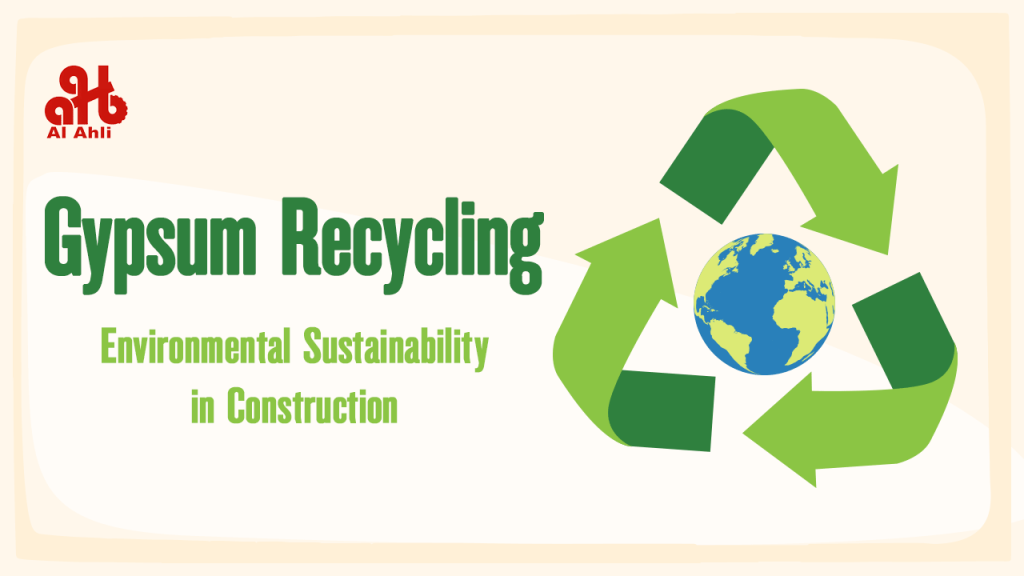Gypsum recycling
Process of recycling construction gypsum waste into a raw material.
Definition | Gypsum recycling involves turning gypsum waste from construction into recycled gypsum for use as a raw material in new products. |
Sources of Gypsum Waste | Primarily consists of waste from gypsum boards like drywall, wallboards, and includes gypsum blocks and plaster. |
Recycling Process | Involves processing to remove contaminants and separating paper from the gypsum core through mechanical processes. |

Gypsum is indeed recyclable and is considered an eternally recyclable material. The recycling process involves converting gypsum waste from construction activities back into usable raw material, which can replace virgin gypsum in the manufacturing of new products. This closed-loop recycling is particularly significant in the context of sustainability and resource efficiency.

Gypsum Recycling Process
The gypsum recycling typically involves several steps:
Collection and Sorting: Gypsum waste, such as plasterboard, is collected and sorted to remove contaminants like nails, screws, and other construction debris.
Mechanical Processing: The sorted gypsum waste undergoes mechanical processes such as grinding and sieving. In some cases, the paper facing of plasterboard is separated from the gypsum core, although materials like gypsum blocks do not require this step since they lack paper.
Quality Control: The recycled gypsum must meet specific quality standards to be reused in the production of new gypsum products.
Environmental Benefits
Gypsum recycling has several environmental advantages:
Reduction of Landfill Waste: Gypsum waste in landfills can decompose and produce harmful gases like hydrogen sulfide and methane, contributing to greenhouse gas emissions. Recycling mitigates this issue.
Resource Conservation: By recycling gypsum, the demand for virgin gypsum is reduced, which helps conserve natural resources and minimizes the environmental impact associated with quarrying and processing new gypsum.
Energy Savings: Recycling gypsum can save significant amounts of energy and raw materials, contributing to a more sustainable manufacturing process. For instance, recycling one ton of gypsum can save up to 28 kWh of energy.
Current Recycling Practices
In Europe, gypsum recycling is well established, with systems in place to process substantial amounts of gypsum waste. For example, Denmark has achieved a recycling rate of around 60% for gypsum waste, and advanced recycling facilities can incorporate up to 30% recycled gypsum into new products.
In North America, efforts are ongoing to improve recycling rates, particularly in new construction where significant amounts of scrap gypsum board are generated. Clean scrap is more readily recycled than demolition waste due to lower contamination levels.
Overall, gypsum recycling not only supports environmental sustainability but also promotes a circular economy in the construction industry.
Using recycled gypsum in construction projects
Recycled gypsum can be used in various construction projects, but its application is not universal due to several factors.
Acceptable Uses of Recycled Gypsum
Gypsum Board Production: Recycled gypsum is widely accepted as a raw material for producing new gypsum boards. This is the most common application, leveraging the quality of recycled gypsum to create products comparable to those made with virgin materials.
Agricultural Uses: Recycled gypsum is also utilized as a soil amendment and fertilizer, enhancing soil structure and providing essential nutrients.
Cement Manufacturing: It can be incorporated into cement production, where it helps control setting times and improves the overall quality of the cement.
Limitations and Challenges
Quality Variability: The quality of recycled gypsum can vary significantly, particularly when sourced from demolition projects. Contaminants and impurities can affect its performance in applications such as mortars or plasters, leading to reluctance in its acceptance for these purposes.
Industry Prejudice: There is a prevailing skepticism in the construction industry regarding the use of recycled gypsum for certain applications, particularly for gypsum spray plasters. This skepticism stems from concerns about workability and consistency, which are critical for effective application.
Regulatory and Economic Factors: Economic considerations, such as the lower cost of landfill disposal compared to recycling, can deter the use of recycled gypsum. Additionally, regulatory changes affecting the availability of alternative gypsum sources, like flue-gas desulfurization gypsum, may influence the adoption of recycled materials.
Conclusion
While recycled gypsum is a valuable resource with established uses in gypsum board production and agriculture, its application in all construction projects is limited by quality concerns, industry acceptance, and economic factors. As recycling technologies and practices improve, the potential for broader use in construction may increase.

